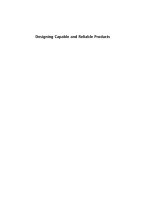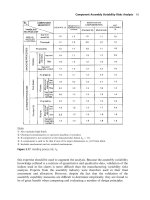Designing Capable and Reliable Products Episode 1 Part 1 docx
Bạn đang xem bản rút gọn của tài liệu. Xem và tải ngay bản đầy đủ của tài liệu tại đây (212.73 KB, 16 trang )
Designing Capable and Reliable Products
Designing Capable and
Reliable Products
J.D. Booker
University of Bristol, UK
M. Raines
K.G. Swift
School of Engineering
University of Hull, UK
OXFORD AUCKLAND BOSTON JOHANNESBURG MELBOURNE NEW DELHI
Butterworth-Heinemann
Linacre House, Jordan Hill, Oxford OX2 8DP
225 Wildwood Avenue, Woburn, MA 01801-2041
A division of Reed Educational and Professional Publishing Ltd
First published 2001
# J.D. Booker, M. Raines and K.G. Swift 2001
All rights reserved. No part of this publication
may be reproduced in any material form (including
photocopying or storing in any medium by electronic
means and whether or not transiently or incidentally
to some other use of this publication) without the
written permission of the copyright holder except
in accordance with the provisions of the Copyright,
Designs and Patents Act 1988 or under the terms of a
licence issued by the Copyright Licensing Agency Ltd,
90 Tottenham Court Road, London, England W1P 9HE.
Applications for the copyright holder's written permission
to reproduce any part of this publication should be addressed
to the publishers
British Library Cataloguing in Publication Data
A catalogue record for this book is available from the British Library
ISBN 0 7506 5076 1
Library of Congress Cataloging in Publication Data
A catalog record for this book is available from the Library of Congress
Typeset by Academic & Technical Typesetting, Bristol
Printed and bound by MPG Ltd, Bodmin, Cornwall
Preface
Notation
Abbreviations
1 Introduction to quality and reliability
engineering
1.1 Statement of the problem
1.2 The costs of quality
1.3 How and why products fail
1.4 Risk as a basis for design
1.5 Designing for quality
1.6 Designing for reliability
1.7 Summary
2 Designing capable components and
assemblies
2.1 Manufacturing capability
2.2 Component Manufacturing Variability Risks Analysis
2.3 Assembly capability
2.4 Component Assembly Variablility Risks Analysis
2.5 The effects of non-conformance
2.6 Objectives, application and guidance for an analysis
2.7 Case studies
2.8 Summary
3 Designing capable assembly stacks
3.1 Introduction
3.2 Background
3.3 Tolerance stack models
3.4 A methodology for assembly stack analysis
3.5 Application issues
3.6 Cash study - revisiting the solenoid design
3.7 Summary
4 Designing reliable products
4.1 Deterministic versus probabilistic design
4.2 Statistical methods for probabilistic design
4.3 Variables in probabilistic design
4.4 Stress-strength interface (SSI) analysis
4.5 Elements of stress analysis and failure theory
4.6 Setting reliability targets
4.7 Application issues
4.8 Case studies
4.9 Summary
5 Effective product development
5.1 Introduction
5.2 Product development models
5.3 Tools and techniques in product development
5.4 Supporting issues in effective product development
5.5 Summary
Appendix 1 Introductory statistics
Statistical representation of data ?
Representing data using histograms ?
Properties of the Normal distribution ?
The Standard Normal distribution ?
Appendix 2 Process capability studies ?
Process capability concepts ?
Process capability index ?
Appendix 3 Overview of the key tools and
techniques ?
A Failure Mode and Effects Analysis (FMEA) ?
B Quality Function Deployment (QFD) ?
C Design for Assembly/Design for Manufacture
(DFA/DFM) ?
D Design of Experiments (DOE) ?
Appendix 4 Process capability maps ?
Index to maps ?
Sheet A Casting processes ?
Sheet B Casting processes (continued) ?
Sheet C Casting processes (continued) ?
Sheet D Hot forging processes ?
Sheet E Cold forming processes ?
Sheet F Cold drawing and rolling processes ?
Sheet G Extrusion processes ?
Sheet H Sheet metalworking processes ?
Sheet I Sheet metalworking processes (continued) ?
Sheet K Machining processes ?
Sheet L machining processes (continued) ?
Sheet M Powder metallurgy processes ?
Sheet N Plastic moulding processes ?
Sheet P Elastomer and composite moulding processes ?
Sheet Q Non-traditional machining processes 6
Sheet R Non-traditional maching processes (continued) ?
Appendix 5 Sample case studies used in
validation ?
Appendix 6 Additional assembly process risk
charts ?
A Miscellaneous operations ?
B Later mechanical deformation ?
C Adhesive bonding ?
D Brazing and soldering ?
E Resistance welding ?
F Fusion welding ?
Appendix 7 Blank conformability analysis
tables ?
A Variability risks results table ?
B Conformability matrix ?
Appendix 8 Assembly problems with two
tolerances ?
Appendix 9 Properties of continuous
distributions ?
A Probability Density Functions (PDF) ?
B Equivalent mean and standard deviation ?
C Cumulative Distribution Functions (CDF) ?
Appendix 10 Fitting distributions to data using
linear regression ?
A Cumulative ranking equations ?
B Linear rectification equations and plotting positions C
C Distribution parameters from linear regression
constants A0 and A1 C
Appendix 11 Solving the variance equation ?
A Partial derivative method ?
B Finite difference method ?
C Monte Carlo simulation ?
D Sensitivity analysis ?
Appendix 12 Simpson’s Rule for numerical
integration ?
Example 1 ?
Example 2 ?
Area under a Function ?
References ?
Bibliography ?
Index ?
companies, and in particular how failure costs can be related to design decisions and
the way products later fail in service. An introduction to risk and risk assessment
provides the reader with the underlying concepts of the approaches for designing
capable and reliable products. The chapter ends with a review of the key principles
in designing for quality and reliability, from both engineering design research and
industrial viewpoints.
Capable design is part of the Design for Quality (DFQ) concept relating to quality
of conformance. Chapter 2 presents a knowledge-based DFQ technique, called
Conformability Analysis (CA), for the prediction of process capability measures in
component manufacture and assembly. It introduces the concepts of component manu-
facturing capability and the relationships between tolerance, variability and cost. It
then presents the Component Manufacturing Variability Risks Analysis, the ®rst
stage of the CA methodology from which process capability estimates can be deter-
mined at the design stage. The development of the knowledge and indices used in an
analysis is discussed within the concept of an `ideal design'. The need for assembly
variability determination and the inadequacy of the DFA techniques in this respect
is argued, followed by an introduction to assembly sequence diagrams and their use
in facilitating an assembly analysis. The Component Assembly Variability Risks
Analysis is then presented, which is the second stage of the CA methodology. Finally
explored in this chapter is a method for linking the variability measures in manufac-
turing and assembly with design acceptability and the likely costs of failure in service
through linkage with FMEA.
The use of CA has proved to be bene®cial for companies introducing a new pro-
duct, when an opportunity exists to use new processes/technologies or when design
rules are not widely known. Design conformance problems can be systematically
addressed, with potential bene®ts, including reduced failure costs, shorter product
development times and improved supplier dialogue. A number of detailed case studies
are used to demonstrate its application at many dierent levels.
Chapter 3 reports on a methodology for the allocation of capable component
tolerances within assembly stack problems. There is probably no other design
eort that can yield greater bene®ts for less cost than the careful analysis and assign-
ment of tolerances. However, the proper assignment of tolerances is one of the least
understood activities in product engineering. The complex nature of the problem is
addressed, with background information on the various tolerance models commonly
used, optimization routines and capability implications, at both component manufac-
turing and assembly level. Here we introduce a knowledge-based statistical approach
to tolerance allocation, where a systematic analysis for estimating process capability
levels at the design stage is used in conjunction with methods for the optimization of
tolerances in assembly stacks. The method takes into account failure severity through
linkage with FMEA for the setting of realistic capability targets. The application of
the method is fully illustrated using a case study from the automotive industry.
Product life-time prediction, cost and weight optimization have enormous implica-
tions on the business of engineering manufacture. Using large Factors of Safety in a
deterministic design approach fails to provide the necessary understanding of the
nature of manufacture, material properties, in-service loading and their variability.
Probabilistic approaches oer much potential in this connection, but have yet to be
taken up widely by manufacturing industry. In Chapter 4, a probabilistic design
x Preface
methodology is presented providing reliability estimates for product designs with
knowledge of the important product variables. Emphasis will be placed on an analysis
for static loading conditions. Methods for the prediction of process capability indices
for given design geometry, material and processing route, and for estimating material
property and loading stress variation are presented to augment probabilistic design
formulations. The techniques are used in conjunction with FMEA to facilitate the
setting of reliability targets and sensitivity analysis for redesign purposes. Finally, a
number of fully worked case studies are included to demonstrate the application of
the methods and the bene®ts that can accrue from their usage.
Chapter 5 discusses the important role of the product development process in driv-
ing the creation of capable and reliable products. Guidance on the implementation
problems and integrated use of the main tools and techniques seen as bene®cial is a
key consideration. The connection of the techniques presented in the book with
those mentioned earlier will be explored, together with their eective positioning
within the product development process. Also touched on are issues such as design
reviews, supplier development and Total Quality Management (TQM) within the
context of producing capable and reliable products.
The book provides eective methods for analysing mechanical designs with respect
to their capability and reliability for the novice or expert practitioner. The methods
use physically signi®cant data to quantify the engineering risks at the design stage
to obtain more realistic measures of design performance to reduce failure costs. All
core topics such as process capability indices and statistical modelling are covered
in separate sections for easy reference making it a self-contained work, and detailed
case studies and examples are used to augment the approaches. The book is primarily
aimed at use by design sta for `building-in' quality and reliability into products with
application of the methods in a wide range of engineering businesses. However, the
text covers many aspects of quality, reliability and product development of relevance
to those studying, or with an interest in, engineering design, manufacturing or
management. Further, it is hoped that the text will be useful to researchers in the
®eld of designing for quality and reliability.
The authors are very grateful to Mr Stan Field (formerly Quality Director at British
Aerospace Military Aircraft & Aerostructures Ltd) and to Mr Richard Batchelor of
TRW for their invaluable support and collaboration on this work. Thanks are also
extended to Mr Bob Swain of the School of Engineering for his help with the prepara-
tion of many drawings. The Engineering & Physical Sciences Research Council, UK
(Grant Nos GR/J97922 and GR/L62313), has funded the work presented in this
book.
J.D. Booker, M. Raines, K.G. Swift
School of Engineering, University of Hull, UK
May 2000
Preface xi
s
p
Surface roughness to process risk
S FMEA Severity Rating, strength
Su Ultimate tensile strength
Sy Uniaxial yield strength
t Bilateral tolerance
T Unilateral tolerance
t
p
Tolerance to process risk
V Variance
w Class width
z Standard deviation multiplier, Standard Normal variate
( ) Function of
È
SND
Function of the Standard Normal Distribution
Mean
Standard deviation
H
Standard deviation estimate for a shifted distribution
Æ Sum of
u
Ultimate shear strength
y
Shear yield strength
xiv Notation
The focus on quality improvement in design is not misplaced. Studies have estimated
that the majority of all costs and problems of quality are created in product
development. Focusing on the generation of product faults in product development,
we ®nd that typically 75% originate in the development and planning stages, but
compounding the problem, around 80% of faults remain undetected until ®nal test
or when the product is in use (see Figure 1.2). The consequences of a design fault
can be crippling: massive recalls, costly modi®cations, loss of reputation and sales, or
even going out of business! Engineers and designers sometimes assume that someone
else is causing product costs, but it is the details of how a product is designed that
generates its costs in nearly every category (Foley and Bernardson, 1990).
The most signi®cant cost savings can result from changes in product design rather
than, say, from changes in production methods (Bralla, 1986). The costs `®xed' at the
planning and design stages in product development are typically between 60 and 85%,
but the costs actually incurred may only be 5% of the total committed for the project.
Therefore, the more problems prevented early on, through careful design, the fewer
problems that have to be corrected later when they are dicult and expensive to
change (Dertouzos et al., 1989). It is often the case that quality can be `built in' to
the product without necessarily increasing the overall cost (Soderberg, 1995).
However, to achieve this we need to reduce the `knowledge gap' between design
and manufacture as illustrated in Figure 1.3.
Design is recognized as a major determinant of quality and therefore cost. It is also
a driving factor in determining the `time to market' of products (Welch and Dixon,
1992). Historically, designers have concerned themselves with product styling,
function and structural integrity (Craig, 1992). Now the designer has the great
responsibility of ensuring that the product will conform to customer requirements,
Figure 1.1
Effect of quality loss on the pro®tability of a product development project
2 Introduction to quality and reliability engineering
comply to speci®cation, meet cost targets and ensure quality and reliability in every
aspect of the product's use, all within compressed time scales.
From the above, it is clear that the designer needs to be aware of the importance of
the production phase of product development. As far as quality is concerned, the
designer must aim to achieve the standards demanded by the speci®cation, but at the
same time should be within the capabilities of the production department. Many
designers have practical experience of production and fully understand the limitations
and capabilities that they must work within. Unfortunately, there are also many who
do not (Oakley, 1993). From understanding the key design/manufacture interface
issues, the designer can signi®cantly reduce failure costs and improve business
competitiveness. One of the most critical interface issues in product development is
that concerning the allocation of process capable tolerances.
There is probably no other design improvement eort that can yield greater bene®ts
for less cost than the careful analysis and assignment of tolerances (Chase and
Parkinson, 1991). The eects of assigning tolerances on the design and manufacturing
functions are far reaching, as shown in Figure 1.4. Product tolerances aect customer
satisfaction, quality inspection, manufacturing and design, and are, therefore, a
critical link between design, manufacture and the customer (Gerth, 1997; Soderberg,
1995). They need to be controlled and understood!
Each product is derived from individual pieces of material, individual components
and individual assembly processes. The properties of these individual elements have a
probability of deviating from the ideal or target value. In turn, the designer de®nes
allowable tolerances on component characteristics in anticipation of the manu-
facturing variations, but more often than not, with limited knowledge of the cost
Figure 1.2
Origination and elimination of faults in product development (DTI, 1992)
Statement of the problem 3
implication or manufacturing capability in order to meet the speci®cation (Craig,
1992; Korde, 1997). When these variations are too large or o target, the usability
of the product for its purpose will be impaired (Henzold, 1995). It therefore becomes
important to determine if a characteristic is within speci®cation, and, if so, how far it
is from the target value (Vasseur et al., 1992).
Improperly set tolerances and uncontrolled variation are one of the greatest causes
of defects, scrap, rework, warranty returns, increased product development cycle
time, work ¯ow disruption and the need for inspection (Gerth and Hancock, 1995).
If manufacturing processes did not exhibit variation, quality problems would not
arise, therefore reducing the eects of variability at the design stage, in a cost-eective
way, improves product quality (Bergman, 1992; Kehoe, 1996).
A signi®cant proportion of the problems of product quality can directly result from
variability in manufacturing and assembly (Craig, 1992). However, the diculties
associated with identifying variability at the design stage mean that these problems
are detected too late in many cases, as indicated by a recent study of engineering
change in nine major businesses from the aerospace, industrial and automotive
sectors (Swift et al., 1997). On average, almost 70% of product engineering rework
was due to quality problems, that is failure to satisfy customer expectations and to
Figure 1.3
Commitment and incursion of costs during product development and the `knowledge gap'
principle (adapted from Fabrycky, 1994)
4 Introduction to quality and reliability engineering









